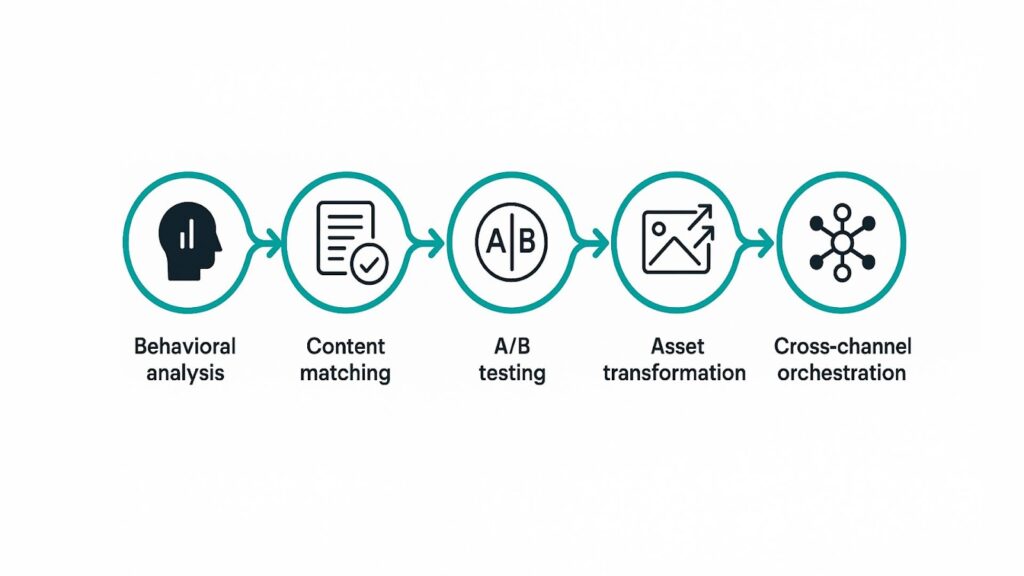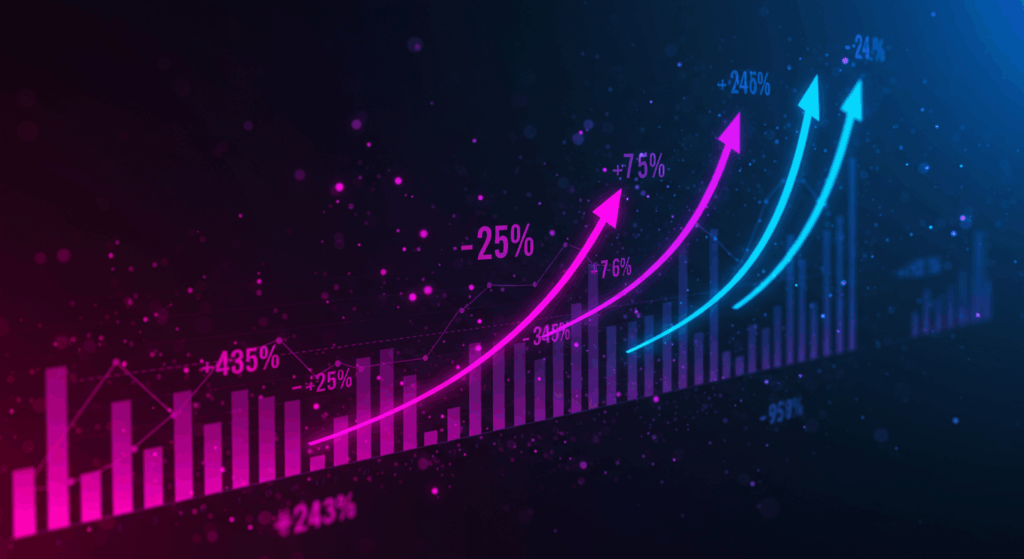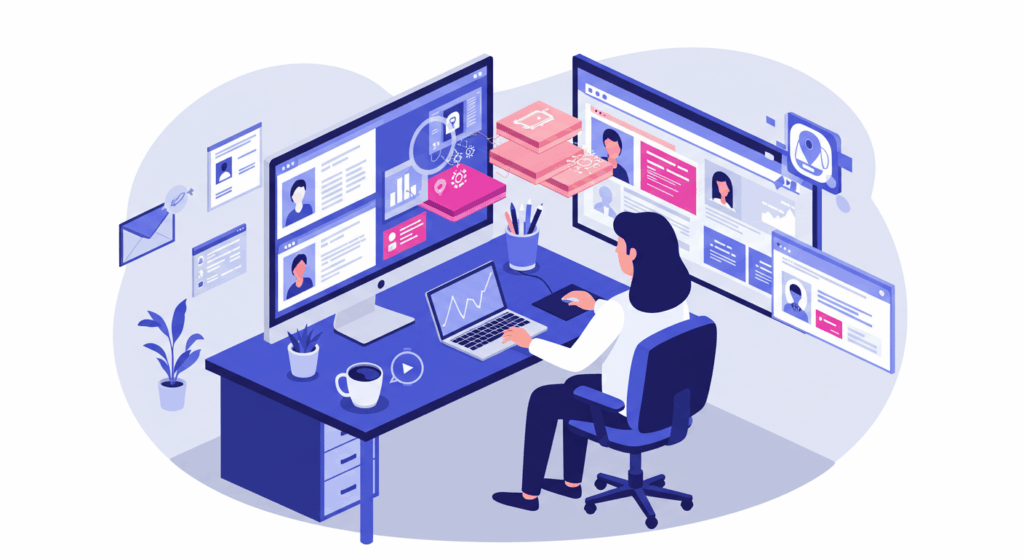AI agents are revolutionizing content personalization by automating complex workflows that previously required extensive manual intervention.
- Performance gains: Organizations report faster content discovery and higher revenue from AI-powered personalization
- Real-time capabilities: AI agents analyze visitor behavior and deliver personalized content in microseconds
- Workflow automation: From behavioral analysis to cross-channel orchestration, AI agents handle end-to-end personalization processes
- Strategic advantage: Companies leveraging AI agents in digital marketing achieve unprecedented scale and efficiency in content operations
The future belongs to organizations that can seamlessly integrate AI agents into their content personalization strategies while maintaining human oversight for strategic decisions.
The marketing landscape has reached a pivotal moment where personalization is expected. Modern consumers demand experiences tailored to their individual preferences, behaviors, and contexts. However, traditional personalization approaches struggle to keep pace with the volume and velocity required for meaningful engagement at scale.
AI agents in digital marketing enable proactive content personalization. Unlike basic automation tools that follow predetermined rules, these intelligent systems continuously learn, adapt, and make real-time decisions about content delivery. The result? Marketing teams can finally achieve the holy grail of personalization: delivering the right content to the right person at precisely the right moment.
What Are AI Agents in Digital Marketing?
AI agents are autonomous software systems that perceive their environment, make intelligent decisions, and take actions to achieve specific marketing objectives. In the context of content personalization, these agents function as digital assistants that never sleep, continuously analyzing user behavior and optimizing content delivery across all touchpoints.
The distinction between traditional automation and AI agents lies in their capacity for independent decision-making. While conventional marketing automation follows “if-then” logic, AI agents in digital marketing employ machine learning algorithms to process complex data patterns and make nuanced choices about content selection, timing, and presentation.
Current adoption rates tell a compelling story. Research indicates that 88% of marketers now use AI in their daily operations, with companies implementing AI-driven personalization reporting significant performance improvements. Organizations leveraging these technologies achieve faster content discovery and reduce customer acquisition costs.
The technology stack powering these agents includes natural language processing for content understanding, computer vision for visual asset analysis, and predictive analytics for behavioral forecasting. This convergence enables unprecedented automation capabilities that were impossible just a few years ago.
How Do AI Agents Automate Content Personalization Workflows?
The automation of content personalization through AI agents operates on multiple interconnected levels, creating a sophisticated ecosystem that responds to user behavior in real time. Understanding these operational mechanics reveals why organizations are rapidly adopting these technologies.
Real-time behavioral analysis forms the foundation of AI agent workflows. These systems continuously monitor user interactions across digital touchpoints, building comprehensive behavioral profiles that inform content decisions. Every click, scroll, and engagement event contributes to an evolving understanding of individual preferences and intent.
Dynamic content decisioning represents the core intelligence layer where AI agents evaluate multiple content options against user profiles and contextual factors. This process considers not only current behavior but also predictive models that anticipate future actions and preferences. The speed of these decisions (often measured in milliseconds) enables truly responsive personalization.
Automated asset selection and deployment streamlines the technical execution of personalization strategies. AI agents access content libraries, apply real-time transformations when necessary, and deploy assets through appropriate channels without human intervention. This capability dramatically reduces the time between content creation and personalized delivery.
Cross-channel orchestration ensures consistency and continuity across all customer touchpoints. AI agents maintain context as users move between email, social media, websites, and mobile applications, creating seamless experiences that reinforce messaging and drive engagement.
The integration of these workflow components creates compound value. When behavioral analysis informs better content decisions, which in turn generate more relevant assets for cross-channel deployment, the entire personalization ecosystem becomes more effective and efficient.
5 Key AI Agent Workflows for Content Personalization
The practical application of AI agents in content personalization manifests through five critical workflows that collectively transform how organizations deliver tailored experiences. Each workflow addresses specific challenges while contributing to a comprehensive personalization strategy.

Workflow 1: Real-time Visitor Behavior Analysis and Content Matching
This foundational workflow begins the moment a visitor arrives at any digital touchpoint. AI agents immediately analyze available data points, including referral source, device type, geographic location, and any historical interaction data. Within milliseconds, the system creates or updates a behavioral profile that guides all subsequent content decisions.
The matching process involves evaluating content library assets against the visitor’s profile, considering factors like content performance history, audience segment alignment, and contextual relevance. Advanced AI personalization techniques enable systems to understand not just what content to show but when and how to present it for maximum impact.
Workflow 2: Automated A/B Testing and Optimization
Traditional A/B testing requires weeks or months to generate statistically significant results. AI agents compress this timeline by continuously testing multiple content variations while automatically routing traffic to higher performing options. This process, known as multi-armed bandit testing, optimizes performance in real-time rather than waiting for test completion.
The optimization includes engagement depth, brand affinity measures, and lifetime value indicators. AI agents balance short-term performance gains with long-term relationship building, ensuring optimization strategies align with broader business objectives.
Workflow 3: Dynamic Asset Transformation and Delivery
Modern content personalization often requires real-time modifications to existing assets. AI agents can automatically adjust images, modify text elements, and generate entirely new content variations based on user preferences and behavioral patterns. This capability eliminates the need for pre-creating every possible content variation.
The transformation process considers technical requirements like device specifications and bandwidth limitations alongside personalization goals. The result is content that’s relevant and optimally formatted for each user’s specific context and technical environment.
Workflow 4: Cross-channel Personalization Orchestration
Maintaining personalization consistency across multiple channels requires sophisticated coordination that exceeds human capacity at scale. AI agents synchronize messaging, timing, and content selection across email, social media, advertising platforms, and owned digital properties to create cohesive experiences.
This orchestration includes frequency management to prevent over-communication and channel optimization to reach users through their preferred touchpoints. The system learns from cross-channel performance data to continuously refine future orchestration decisions.
Workflow 5: Predictive Content Gap Identification
Perhaps the most strategic workflow involves identifying opportunities for new content creation based on user behavior patterns and performance data. AI agents analyze content consumption patterns to identify gaps where personalized content could drive additional engagement or conversions.
This predictive capability extends to competitive analysis, seasonal trend identification, and emerging topic detection. By proactively surfacing these insights, AI agents enable content teams to stay ahead of audience needs rather than reacting to missed opportunities.
How Does Data-Driven Content Marketing Power AI Agent Workflows?
The effectiveness of AI agents in content personalization depends on the quality and comprehensiveness of underlying data systems. Data-driven content marketing provides the fuel that powers intelligent decision-making and enables AI agents to deliver increasingly sophisticated personalization experiences.
Customer data integration is the cornerstone of effective AI agent workflows. This process involves consolidating information from multiple sources, including website analytics, customer relationship management systems, social media platforms, and email marketing tools. The challenge lies in creating unified customer profiles that AI agents can interpret and act upon.
Behavioral pattern recognition transforms raw interaction data into actionable insights about customer preferences, content consumption habits, and engagement triggers. AI-driven personalization strategies leverage machine learning algorithms to identify subtle patterns that human analysts might miss, such as the correlation between specific content types and downstream conversion behaviors.
The sophistication of modern data analysis enables AI agents to understand context and intent beyond surface-level interactions. For example, a user browsing premium products might indicate high purchase intent, while someone consuming educational content might be in an earlier research phase. These contextual insights inform not just what content to present but how to frame messaging for maximum relevance.
Predictive analytics represents the evolution from reactive to proactive content marketing. By analyzing historical patterns and current behavior, AI agents can anticipate future content needs and preferences. Organizations can create and position content before demand peaks, capturing audience attention at optimal moments.

The integration of first-party and third-party data sources enriches the context available to AI agents while respecting privacy requirements. As privacy regulations continue to evolve, organizations that build robust first-party data strategies will maintain competitive advantages in personalization effectiveness.
What Makes Dynamic Content Personalization Effective?
Dynamic content personalization has evolved, driven by advances in AI technology and changing consumer expectations. Understanding what distinguishes effective personalization in 2025 helps organizations prioritize their investment and development strategies.
Real-time adaptability has become the baseline expectation for modern personalization systems. Consumers expect immediate recognition and relevant content regardless of how they engage with brands. Organizations need AI agents capable of instantly processing new information and updating content recommendations without perceptible delay.
The technical infrastructure supporting real-time personalization includes edge computing capabilities that process decisions close to users, reducing latency and improving response times. Content delivery optimization ensures that personalized content loads quickly across all devices and network conditions.
Omnichannel consistency ensures that personalization doesn’t create jarring transitions as users move between touchpoints. AI agents maintain context and continuity, preventing the frustrating experience of receiving irrelevant content on one channel immediately after engaging with highly relevant content on another.
This consistency extends to messaging tone, visual presentation, and promotional offers. When AI agents coordinate across channels, they create seamless brand experiences that reinforce rather than contradict each interaction point.
Performance optimization distinguishes successful personalization initiatives from those that merely implement technology without strategic focus. Effective systems balance multiple objectives, including engagement, conversion, customer satisfaction, and long-term value creation.
The optimization process involves continuous learning from both successful and unsuccessful personalization attempts. AI agents analyze which content combinations, timing strategies, and presentation formats drive desired outcomes, then apply these insights to future decisions.
How Do Organizations Implement AI Agent Workflows Successfully?
The successful implementation of AI agent workflows for content personalization requires careful planning, appropriate technology infrastructure, and change management strategies that align with organizational capabilities and objectives.
Technology infrastructure requirements include data architecture, integration capabilities, and performance monitoring systems. Organizations need robust customer data platforms that can support real-time data processing and decision-making at scale.
The integration challenge involves connecting AI agent systems with existing marketing technology stacks without disrupting current operations. This process typically requires API-based connections, data synchronization protocols, and testing frameworks that ensure reliability and performance.
Integration strategies should prioritize high-impact, low-risk implementations that demonstrate value quickly while building organizational confidence in AI capabilities. Many organizations begin with specific use cases like email personalization or website content optimization before expanding to comprehensive omnichannel strategies.
Successful integration also requires collaboration between marketing, technology, and data teams to ensure that AI agent workflows align with business objectives and operational constraints. This cross-functional approach prevents silos that could limit the effectiveness of personalization initiatives.
Performance measurement must encompass both quantitative metrics, like conversion rates and engagement levels, and qualitative indicators, such as customer satisfaction and brand perception. AI agents generate vast amounts of performance data, but organizations need frameworks for interpreting this information and translating insights into strategic decisions.
The measurement strategy should include both real-time monitoring for operational optimization and periodic strategic reviews that assess the overall impact of AI agent implementations on business objectives.
What Does the Future Hold for AI-Powered Content Personalization?
The trajectory of AI-powered content personalization points toward increasingly sophisticated systems that blur the lines between artificial and human intelligence in marketing applications. Understanding these trends helps organizations prepare for the next wave of technological advancement.

2025 trends and predictions indicate a shift from experimental AI implementations to strategic, business-critical applications. Industry analysis suggests that 2025 will mark the year when AI must prove ROI rather than simply demonstrating technical capability.
The evolution toward autonomous marketing systems will accelerate, with AI agents taking responsibility for entire campaign lifecycles from strategy development through execution and optimization. This shift will free human marketers to focus on creative strategy, brand positioning, and customer relationship building.
Emerging capabilities include advanced natural language generation for dynamic content creation, computer vision for real-time image personalization, and emotional intelligence for sentiment-aware content adaptation. These capabilities will enable personalization experiences that feel increasingly natural and intuitive.
The integration of generative AI with personalization systems will enable the creation of unique content variations for individual users rather than selecting from pre-existing content libraries. This capability shifts toward truly individual rather than segment-based personalization.
Strategic recommendations for organizations preparing for this future include investing in data quality and infrastructure, developing AI literacy across marketing teams, and establishing governance frameworks for responsible AI use in customer interactions.
Organizations should also focus on building flexible, composable technology architectures that can adapt to rapid changes in AI capabilities and consumer expectations. The companies that thrive will be those that view AI agents as strategic partners rather than just operational tools.
Transform Your Content Strategy: The AI Agent Advantage
The evolution of content personalization through AI agents represents a fundamental reimagining of how organizations connect with their audiences. As consumer expectations continue to rise and competition intensifies, the ability to deliver relevant, timely, and engaging content at scale becomes a critical differentiator.
The workflows and strategies outlined demonstrate that successful AI agent implementation requires thoughtful integration of technology, data, and human expertise. Organizations that master this balance position themselves to capture the significant value that personalization offers while building sustainable competitive advantages.
Aprimo’s intelligent content operations platform combines advanced AI agents with comprehensive digital asset management to streamline your personalization processes and deliver exceptional customer experiences at scale. Discover how Aprimo can accelerate your content operations and unlock the full potential of AI-driven personalization for your organization.
Frequently Asked Questions
How do AI agents differ from traditional marketing automation tools? AI agents operate autonomously using machine learning to make intelligent decisions based on real-time data analysis, while traditional automation follows predetermined rules and workflows. AI agents can adapt their responses based on new information and patterns, making them far more flexible and effective for complex personalization scenarios.
What data do AI agents need to personalize content effectively? AI agents require behavioral data (clicks, browsing patterns, engagement history), demographic information, contextual data (device, location, time), and content performance metrics. The more comprehensive and high-quality the data, the more accurate and effective the personalization becomes.
How quickly can organizations expect to see results from AI agent implementation? Organizations typically see initial performance improvements within 30–60 days of implementation, with more significant results emerging after 3–6 months as AI agents learn from accumulated data. The timeline depends on data quality, content library size, and implementation complexity.What are the main challenges in implementing AI agents for content personalization? Key challenges include data integration complexity, ensuring privacy compliance, managing technology infrastructure requirements, training teams on AI capabilities, and maintaining human oversight while allowing autonomous operation. Success requires careful planning and cross-functional collaboration.


